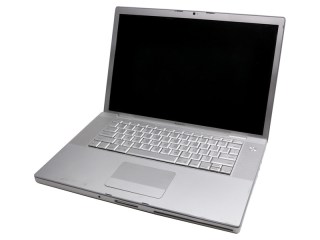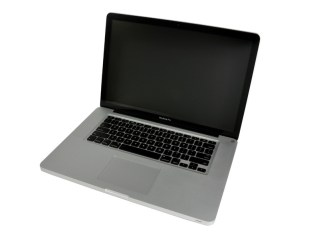The new MacBook Pro, announced at WWDC 2012, with an unprecedented 2,880 x 1,880 pixel display.
So you’ve probably met the new MacBook Pro by now, which I suppose Apple could have called the “MBRetina” but wisely chose not to.
Instead, it’s simply “the next generation MacBook Pro” or “MacBook Pro with Retina display,” a slender, MacBook Air-like 15.4-inch powerhouse with an unprecedented 2,880 x 1,880 pixel display and all the Pro-caliber luxury options.
But while you’re busy debating whether to drop $2,199 on one of these things (or more — over $3,500 if you’re feeling spendy!), how about a quick stroll down memory lane?
(MORE: Apple Shows Off Air-Like MacBook Pro, iOS 6, Mountain Lion and More)
I was a latecomer, in laptop terms, to what Apple was doing in the mobile space by the early 1990s with its first batch of PowerBooks. I grew up with the Apple II in elementary school, of course, but my first “bought with my own money” Apple was actually a Power Macintosh G3, which I ordered in 1998 as much out of curiosity as need.
It didn’t play the kind of games I was into then — System Shock 2, Ultima IX, Planescape: Torment — but I was finishing up a graduate degree in creative writing, and it felt like a writer’s computer. That, and there was Macromedia’s suite of web editing tools to think about, learning the elements of web design in OS 9’s purplish environs and plying alien-looking utilities like Sherlock (Spotlight’s predecessor) and iTools (which went on to become .Mac, then Mobile Me, and most recently, iCloud).
In the early 2000s, ping-ponging between Apple and Windows machines, I impulse-bought one of Apple’s new titanium PowerBook G4s, the 12-inch model (again, more out of curiosity than need). By today’s standards — the 2011 MacBook Air I’m typing this story on, for instance — the PowerBook G4 seems a metal behemoth. And it could put out a lot of heat under duress: Few probably remember this, but the G4 could actually handle World of Warcraft before developer Blizzard ported the codebase over to Intel.
But let’s talk about MacBook Pros, since that’s what Apple just did at WWDC 2012.
2006: The Original MacBook Pro
The story of the MacBook begins with Macworld 2006 (Jan. 9-13), when Steve Jobs unveiled the world’s first Intel-based Apple laptop (on Jan. 10) and dubbed it the “MacBook Pro.”
[youtube=http://www.youtube.com/watch?v=I6JWqllbhXE]
“It’s no secret that we’ve been trying to shoehorn a PowerPC G5 into the PowerBook, and have been unable to do so because of its power consumption,” said Jobs, telling the audience Apple’s design choices were based on “performance per watt.”
According to Apple’s charts, where the G4 delivered 0.27 on this scale, the newer G5 was actually a step backwards at .23. Intel’s then-spanking-new Core Duo processor by comparison? A rating of 1.05, or upwards of 4.5x better performance per watt than the PowerPC G4.
“The Core Duo was designed for this from the start,” said Jobs. “And so today we are introducing a new notebook computer that we are calling the MacBook Pro. It’s a new name because we’re kinda done with power, and because we want Mac in the name of our products.”

iFixit
I bought one immediately. I can’t remember what I paid, exactly, but it was in the mid-$2000s. The 15-inch model wasn’t any lighter than the PowerBook G4, at 5.6 pounds, and it was only a hair thinner, at 1-inch thickness.
But it could be configured with Core Duo processors ranging in speeds from 1.83 GHz to 2.16 GHz, had two memory slots for up to 2GB of RAM, an 80 to 120 GB hard drive, 15.4-inch 1440 x 900 or 17-inch 1680 x 1050 LCD screens, an ATI Mobility Radeon X1600 graphics card, a slot-loading optical DVD drive, integrated 802.11 a/b/g Wi-Fi, Gigabit Ethernet, Bluetooth, two USB ports (three on the 17-inch model), one Firewire port, an ExpressCard 3/4 slot (replacing the PowerBook G4’s PC Card slot) and a dual-link DVI port.
(MORE: A Brief History of Apple’s WWDC Keynotes, 1997-Present)
It was also the first Apple laptop with an iSight camera built-in (until that point, you had to drag an external iSight camera around), it had an infrared sensor that let you manipulate FrontRow with an Apple Remote and it introduced the magnetic “MagSafe” power connector, which allowed quick, simple cord detachment (to prevent the laptop from being dragged off a surface if you accidentally snagged the cord).
These were the pre-unibody models, of course, meaning they still had that (now) funny-looking strip of plastic sandwiched between the base and top. Snapping the laptop apart, then putting it back together — as I did at least twice to install larger hard drives — was quite the trick, especially getting that plastic piece perfectly aligned and flush again.
Thereafter, Apple tweaked the MacBook Pro twice a year: In October 2006, it added Intel’s newer Core 2 Duo processors and larger hard drives to the lineup. In June 2007, it added LED-backlit screens (improving battery life), swapped ATI’s graphics card out for Nvidia’s much faster 8600M GT and added draft support for 802.11n. And between mid 2007 and early 2008, it dropped in faster Core 2 Duo processors (up to 2.5 GHz), bumped the front side bus from 667 MHz to 800 MHz (increasing the speed at which the memory and CPU communicate), added even larger hard drives and raised the total expandable memory to 8GB.
2008: The Unibody MacBook Pro
It took two years for Apple’s next major design trick: During a “special event” held October 14, 2008 at company headquarters in Cupertino, Steve Jobs unveiled a significantly redesigned MacBook Pro with a “precision unibody enclosure” carved from a single block of aluminum and a “multi-touch glass trackpad.”
“It’s exceptionally beautiful on the outside, but also on the inside,” said Jobs, adding that “the unibody saves us half the parts … and it’s a much more rigid, strong construction.”
[youtube=http://www.youtube.com/watch?v=CkEZXd63Eho]
The unibody Pros had their connector ports shifted to the left side of the laptop , freeing up space on the right for the optical drive, which was previously positioned on the lower half’s front side. The lids now closed using magnetic connectors instead of mechanical latches, thus the slightly scooped-out area at middle-front, allowing you to easily pry the lid open.

iFixit
The new Pros also received edge-to-edge glass screens (glossy), much larger glass-covered (supporting up to four-finger gestures) and clickable trackpads (the standalone button disappeared), another front-side bus speed bump from 800 MHz up to 1,066 MHz allowing for faster memory, larger hard drives including a solid state hard drive option and discrete Nvidia GeForce 9000-series mobile graphics cards, both included in each system — one a low-power option for general day-to-day computing, the other a higher-end alternative for more intensive 3D work. They still weighed about the same as the original MacBook Pro — 5.5 pounds, and were only a few millimeters smaller in height and width.
Remember that this was happening roughly eight months after Jobs took the wraps off Apple’s MacBook Air, the company’s folder-thin ultraportable, making the new Pro unveiling less of a radical departure than a high-end integration maneuver — a way of folding the high-end MacBook lineup into Apple’s new, unibody design aesthetic inaugurated by the Air.
The unibody Pro was initially available as a 15-inch only model, though a 17-inch unibody Pro followed a few months later at WWDC 2009 in January. Apple announced a 13-inch aluminum unibody laptop at the October 14, 2008 event, too, but referred to it as a “MacBook” without the “Pro” tag, thus setting it up as the top-end option in the company’s entry-level and otherwise polycarbonate (plastic) MacBook lineup.

